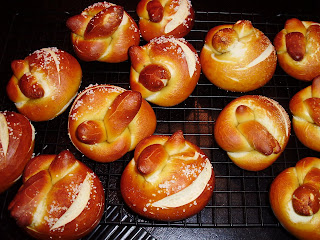Behold, the Power of Pretzels!
 OK, so they don't look like your typical street vendor/concession stand pretzels, but I can confirm they taste about eight million times better...
OK, so they don't look like your typical street vendor/concession stand pretzels, but I can confirm they taste about eight million times better...This is the year of the pretzel for me. My goal is to achieve pretzel perfection for the day that I decide to open a German beer garden. This weekend was the first step on that path, in that it was the first time I tried making pretzels from scratch (I've already mastered the beer drinking part). While not the most attractive things, they did turn out pretty tasty.
I followed a recipe from the Bread: A Baker's Book of Techniques and Recipes, by the head baker at King Arthur Flour....My guess is, they're probably a pretty reliable source when it comes to baked goods. This book is no slouch when it comes to baking--it offers an extensive section on the foundations of baking--ingredients, shaping, etc, then provides recipes in metric and standard measures, as well as commercial production and home baker production (need to make 25 loaves of bread at once?).
The recipe for the pretzels itself, while time-intensive, was not really time-consuming. On Saturday morning, I mixed a pate fermentee (basically a tiny batch of bread dough), that acted as a starter for the dough the next day. This sat in a bowl for 24 hours, then I added it to more flour, water, salt, and yeast, and kneaded it all in my trusty mixer.
After rising for a couple of hours, I cut the dough into 3 ounce "cigars" and let those rest for about 20 minutes:

 ....That one in the bottom right corner is the best one I made. They had to rise (AGAIN!?!) for another half hour, and in the meantime, I constructed a ghetto-fabulous dipping tray, for dipping the raw dough into a solution of water and sodium hydroxide lye beads.
....That one in the bottom right corner is the best one I made. They had to rise (AGAIN!?!) for another half hour, and in the meantime, I constructed a ghetto-fabulous dipping tray, for dipping the raw dough into a solution of water and sodium hydroxide lye beads.
 The tray on top I used as my dipping tray, where I placed about six pretzels before submerging them for about five seconds. From there, they were transferred to a baking sheet, sprinkled with salt (pickling salt for the first round, sea salt for the second) and baked at 450 for 16 minutes.
The tray on top I used as my dipping tray, where I placed about six pretzels before submerging them for about five seconds. From there, they were transferred to a baking sheet, sprinkled with salt (pickling salt for the first round, sea salt for the second) and baked at 450 for 16 minutes.
 When they came out of the oven, they smelled exactly like pretzels should smell, and tasted even better...chewy, yeasty, and salty. With a smear of mustard, they vaulted to amazing. I took them to my sister and brother-in-law's for dinner and they were devoured immediately, so I think they liked them too.
When they came out of the oven, they smelled exactly like pretzels should smell, and tasted even better...chewy, yeasty, and salty. With a smear of mustard, they vaulted to amazing. I took them to my sister and brother-in-law's for dinner and they were devoured immediately, so I think they liked them too.
The recipe for the pretzels itself, while time-intensive, was not really time-consuming. On Saturday morning, I mixed a pate fermentee (basically a tiny batch of bread dough), that acted as a starter for the dough the next day. This sat in a bowl for 24 hours, then I added it to more flour, water, salt, and yeast, and kneaded it all in my trusty mixer.
After rising for a couple of hours, I cut the dough into 3 ounce "cigars" and let those rest for about 20 minutes:

From there, I rolled them out into 16 inch long ropes, and attempted to twist them into the traditional pretzel shape. Some turned out better than others, and as can be expected, they got better as I went along. Also, the dough was able to relax for a longer period of time, so it was easier to roll out.
 ....That one in the bottom right corner is the best one I made. They had to rise (AGAIN!?!) for another half hour, and in the meantime, I constructed a ghetto-fabulous dipping tray, for dipping the raw dough into a solution of water and sodium hydroxide lye beads.
....That one in the bottom right corner is the best one I made. They had to rise (AGAIN!?!) for another half hour, and in the meantime, I constructed a ghetto-fabulous dipping tray, for dipping the raw dough into a solution of water and sodium hydroxide lye beads. The solution is super caustic, so you have to wear gloves, and take care not to splash it all over the place. It's important, though, as it gives the pretzels their signature thin, brown crust. The lye solution evaporates in the oven, so it's completely harmless once the pretzels are baked. Yay, science! (Note: you can also make a weaker solution using baking soda, but I really wanted an excuse to buy food-grade dangerous chemicals...)
 The tray on top I used as my dipping tray, where I placed about six pretzels before submerging them for about five seconds. From there, they were transferred to a baking sheet, sprinkled with salt (pickling salt for the first round, sea salt for the second) and baked at 450 for 16 minutes.
The tray on top I used as my dipping tray, where I placed about six pretzels before submerging them for about five seconds. From there, they were transferred to a baking sheet, sprinkled with salt (pickling salt for the first round, sea salt for the second) and baked at 450 for 16 minutes. When they came out of the oven, they smelled exactly like pretzels should smell, and tasted even better...chewy, yeasty, and salty. With a smear of mustard, they vaulted to amazing. I took them to my sister and brother-in-law's for dinner and they were devoured immediately, so I think they liked them too.
When they came out of the oven, they smelled exactly like pretzels should smell, and tasted even better...chewy, yeasty, and salty. With a smear of mustard, they vaulted to amazing. I took them to my sister and brother-in-law's for dinner and they were devoured immediately, so I think they liked them too. The next step will be mastering the more "traditional" shape, then trying other styles like buns, or bread sticks...Pretzel wrapped sausages, anyone?



Comments